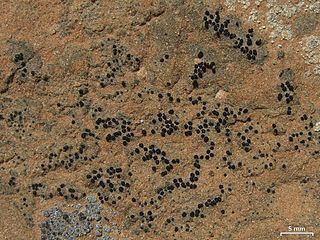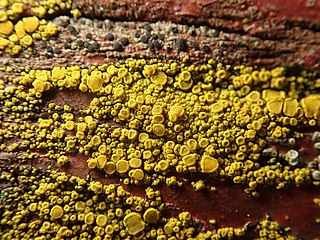
Xylographa is a genus of lichenized fungi in the family Xylographaceae.
Rimularia is a genus of lichenized fungi in the family Trapeliaceae. Rimularia was circumscribed by Finnish botanist William Nylander in 1868.

Toninia is a genus of lichen-forming fungi in the family Ramalinaceae.

Pyxine is a genus of foliose lichens in the family Caliciaceae. The genus has a widespread distribution in tropical regions.

Endocarpon is a genus of saxicolous (rock-dwelling), crustose lichens in the family Verrucariaceae. The genus was circumscribed by German bryologist Johann Hedwig in 1789.

Staurothele is a genus of saxicolous (rock-dwelling), crustose lichens in the family Verrucariaceae. It has about 40 species. When the fungus is part of a lichen, the genus of lichen is commonly called rock pimples.

Lecidella is a genus of crustose lichens in the family Lecanoraceae.

Candelariella is a genus of bright yellow, ocher, or greenish yellow crustose or squamulose lichens in the family Candelariaceae. Members of the genus are commonly called eggyolk lichens, goldspeck lichens, or yolk lichens. The genus was circumscribed in 1894 by Swiss lichenologist Johannes Müller Argoviensis, with Candelariella vitellina assigned as the type species.

Porpidia is a genus of crustose lichens in the family Lecideaceae.

Bryoria is a genus of lichenized fungi in the family Parmeliaceae. Many members of this genus are known as horsehair lichens. The genus has a widespread distribution, especially in boreal and cool temperate areas.

Pilophorus acicularis, commonly known as the nail lichen or the devil's matchstick lichen, is a species of matchstick lichen in the family Cladoniaceae.
Sulzbacheromyces is a genus of basidiolichens in the family Lepidostromataceae. The genus is distinguished from the other genera of Lepidostromataceae by having an entirely crustose thallus and from Multiclavula (Cantharellales) by having a chlorococcoid photobiont. The type species grows on soil in the neotropics.
Sculptolumina is a genus of corticolous lichens in the family Caliciaceae. The genus was circumscribed by Bernhard Marbach in 2000, with Sculptolumina japonica designated as the type species.
Lecanora hafelliana is a species of corticolous (bark-dwelling), crustose lichen in the family Lecanoraceae. It is found in South Korea and in China, where it is fairly common on the bark of deciduous trees such as maple, birch, dogwood, and oak. The lichen was formally described as a new species in 2011 by Lei Lü, Yogesh Joshi, and Jae-Seoun Hur. The type specimen was collected by Hur on Mount Baekwoon at an elevation of 1,037 m (3,402 ft). In China, it was recorded growing on the bark of Korean pine. The lichen has a dull whitish to ash-grey crust-like thallus with a definite margin, but lacking a prothallus. Lecanora hafelliana contains several secondary compounds, including atranorin, zeorin, usnic acid, a complex of compounds related to stictic acid, and hafellic acid. Its specific epithet alludes to the presence of this latter compound.
Pilophorus fruticosus is a species of lichen in the family Cladoniaceae. Found in China, it was formally described as a new species in 2011 by Li-Song Wang and Xin-Yu Wang. The type specimen was collected on the Cangshan Mountain at an elevation of 3,570 m (11,710 ft); here, the lichen was found growing on rock. The lichen has only been recorded from here and another locality in Yunnan, at a similar altitude. It contains the secondary chemicals atranorin and zeorin. The specific epithet fruticosus refers to the form of the lichen's pseudopodetia.
Jasonhuria is a genus of lichenized fungi in the family Teloschistaceae. It is monotypic, containing only the species Jasonhuria bogilana. This species is a saxicolous (rock-dwelling), crustose lichen that occurs in South Korea.
Upretia is a genus of lichen-forming fungi in the family Teloschistaceae. It has three species of saxicolous (rock-dwelling), crustose lichens. Upretia is characterised by its small ascospores and narrow, rod-shaped conidia. The distribution of the genus ranges from mid-altitude rocky terrains in India to both arid and higher altitudinal environments in China.










